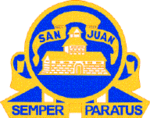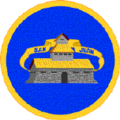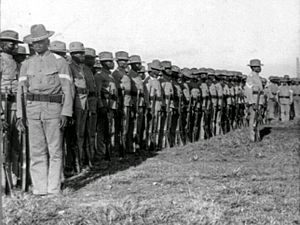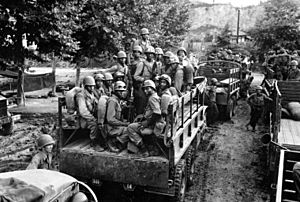24th Infantry Regiment (United States) facts for kids
Quick facts for kids 24th Infantry Regiment |
|
|---|---|

Badge
|
|
| Active | 1869–1951 1995–present |
| Country | |
| Branch | |
| Type | Light Infantry |
| Size | 1 Battalion |
| Part of | 1 |
| Garrison/HQ | Fort Wainwright, Alaska |
| Nickname(s) | "Deuce Four" (special designation) |
| Motto(s) | Semper Paratus (Always Prepared) |
| Engagements | Indian Wars War with Spain Philippine Insurrection Mexican Expedition World War II Korean War Iraq Campaign Afghanistan Campaign Operation Inherent Resolve |
| Commanders | |
| Current commander |
1st Battalion - LTC Ryan Occhuizzo |
| Notable commanders |
Henry C. Merriam Zenas R. Bliss John W. O'Daniel Michael E. Kurilla |
| Insignia | |
| Distinctive unit insignia |  |
The 24th Infantry Regiment is a special unit of the United States Army. It was active from 1869 to 1951, and then again from 1995 until today. For most of its early history, it was mainly made up of African-American soldiers. These units were often called Buffalo Soldier regiments.
Contents
History of the 24th Infantry Regiment
The 24th Infantry Regiment started on November 1, 1869. It was formed from two earlier African-American infantry regiments. All the soldiers were black, many of them veterans or newly freed people. From its start until 1898, the 24th Infantry served across the Western United States. Their jobs included guarding frontier forts and protecting roads from bandits. They also guarded the border between the U.S. and Mexico.
Some soldiers from the 24th Infantry Regiment earned the Medal of Honor for their bravery. These awards were given for actions during:
- The Wham Paymaster robbery in Arizona on May 11, 1889.
- Sergeant Benjamin Brown and Corporal Isaiah Mays received this honor.
- Battles with the Black Seminole Scouts in Texas during the Red River War.
- Private Adam Payne was recognized.
- Another event with the Black Seminole Scouts near Pecos, Texas, on April 25, 1875.
- Sergeant John Ward, Trumpeter Isaac Payne, and Private Pompey Factor were honored.
Fighting in the Spanish–American War
In 1898, the 24th Infantry went to Cuba as part of the U.S. forces in the Spanish–American War. Parts of the 24th Regiment helped attack a Spanish fort in the Battle of El Caney. At the important Battle of San Juan Hill, soldiers from the 24th Infantry, along with other units, bravely attacked and captured the Spanish positions on top of the hill.
Serving in the Philippine–American War

In 1899, the regiment went to the Philippine Islands. Their mission was to help stop a local uprising during the Philippine–American War. The regiment returned to the Philippines several times in the early 1900s. They fought in many battles there. One famous event happened on December 7, 1899. Nine soldiers from the regiment defeated 100 rebel fighters from their trenches.
Guarding the Mexican Border
In 1916, the 24th Infantry was sent to guard the U.S.-Mexico border. They wanted to prevent the Mexican Revolution from causing problems in the United States. When fighting did cross the border, the 24th joined the "Punitive Expedition." This group, led by General Pershing, went into Mexico to fight Pancho Villa's forces. In 1919, the 24th Infantry crossed into Ciudad Juárez again. They stopped violence from spreading across the U.S. border during a conflict there.
The Houston Riot of 1917
Before World War I, soldiers from this all-black unit were sent to guard a military base being built in Houston, Texas. They faced unfair treatment and discrimination from some local white people. A serious incident happened when a black soldier tried to help a black woman who was being arrested. Both the soldier and the woman were jailed. Later, a black corporal who went to ask about the soldier was attacked and arrested. False rumors spread that the corporal had been killed.
This led to the Houston Riot in August 1917. About 150 black soldiers marched towards Houston because of the racial discrimination they had experienced. During the event, 15 white people, including four police officers, and five black soldiers died. After the riot, many soldiers were put on trial. Nineteen men were executed, and 63 were given life sentences. This event showed the serious racial tensions of that time.
The 24th Infantry in World War II
At the start of World War II, the 24th Infantry was at Fort Benning. They helped train other soldiers at the Infantry School. During the war, the 24th Infantry fought in the South Pacific Theatre. They left the U.S. in April 1942 and arrived in the New Hebrides Islands in May.
Parts of the regiment helped build airfields and piers. In August 1943, the 24th moved to Guadalcanal. The 1st Battalion also went to Bougainville from March to May 1944 to help defend the area. The regiment then moved to Saipan and Tinian in December 1944. There, they helped clear out any remaining Japanese forces.
In July 1945, the regiment arrived at the Kerama Islands near Okinawa. At the end of the war, the 24th accepted the surrender of Japanese forces on Aka-shima island. This was the first official surrender of a Japanese Imperial Army garrison. The regiment stayed on Okinawa until 1946.
Service in the Korean War
After World War II, the 24th Regiment was stationed in Japan. In 1947, it became a permanent part of the 25th Infantry Division. Even though the U.S. military officially ended segregation in 1948, the 24th Infantry remained mostly African-American. In June 1950, when North Korea invaded South Korea, the 24th was sent to help in the Korean War.
The 24th Infantry fought across the entire Korean peninsula. They defended the "Pusan Perimeter" and chased the Korean People's Army (KPA) into North Korea. They also faced attacks from Chinese forces and helped push back in U.N. counteroffensives. The regiment earned the Republic of Korea Presidential Unit Citation for their defense of the Pusan Perimeter. Three soldiers from the regiment received the Medal of Honor after they died: Cornelius H. Charlton, Ray E. Duke, and William Thompson.
In September 1950, U.S. and South Korean forces landed at Inchon. This forced the KPA to retreat from the Pusan Perimeter. The 24th Infantry helped chase the KPA. Later, in November, Chinese troops attacked, forcing the U.S. Eighth Army to pull back. The 24th Infantry faced heavy fighting and lost many soldiers during this retreat.
By early March 1951, American and South Korean troops were ready to attack again. The 24th Division advanced across the Han River. While some parts of the regiment performed well, there were also reports of soldiers retreating in disorder. This caused some leaders to lose confidence in the 24th. Despite this, the regiment performed well in later battles. In October 1951, the 24th Infantry Regiment was officially dissolved.
Modern Legacy of the 24th Infantry
The 24th Infantry was brought back to active duty in 1995. It was assigned to the 1st Brigade of the 25th Infantry Division. The regiment served in the Iraq War from 2004 to 2005 and was recognized for its service. In 2006, during a change in the Army, only the 1st Battalion kept the regiment's name. It is now part of the 1st Brigade Combat Team, 11th Airborne Division in Fort Wainwright, Alaska.
Serving in Operation Iraqi Freedom
The 1st Battalion, 24th Infantry Regiment, served in Iraq from October 2004 to October 2005. They were part of a Stryker brigade. The battalion earned many awards, including 5 Silver Stars and 181 Purple Hearts. They played a very important role in the Battle of Mosul (2004). During this battle, the battalion saw some of the toughest fighting of the conflict. They also received the Valorous Unit Award. The battalion commander during this time was General Michael "Erik" Kurilla, who later became a very high-ranking general.
In 2008–2009, the 1-24 Infantry deployed to Diyala Governorate, Iraq again. This time, they had very few casualties. They were recognized with the Meritorious Unit Citation for their work in rebuilding and helping local communities.
Serving in Operation Enduring Freedom
The 1st Battalion, 24th Infantry Regiment, deployed to Afghanistan in 2011–2012. They supported Operation Enduring Freedom. The battalion was responsible for the Zabul Province, working with Romanian units. They were involved in direct combat again and lost several soldiers to Taliban attacks.
Serving in Operation Inherent Resolve
The 1st Battalion, 24th Infantry Regiment, deployed to Iraq again in 2019-2020. Some elements also went to Syria. They were supporting Operation Inherent Resolve. During this time, the unit was attacked by missiles launched by Iran's Islamic Revolutionary Guard Corps Aerospace Force. This was in response to the Assassination of Qasem Soleimani.
Regimental Symbols and Meaning
Regimental Badge
The 24th Infantry Regiment has a special badge. It shows a stone blockhouse with a tower, which is grey with yellow roofs. Around it is a yellow scroll with the words "SAN JUAN" in blue. This whole design is inside a yellow band that says "SEMPER PARATUS" (Always Prepared) in blue.
- What it means: The design reminds everyone of the regiment's brave service in the Santiago campaign of 1898.
- History: The badge was approved on March 27, 1920.
Distinctive Unit Insignia
The regiment also has a distinctive unit insignia, which is a metal and enamel pin. It's a blue circle with a white blockhouse and tower, like the one on the badge. Below it is a gold scroll that says "SAN JUAN" in blue letters. Another gold scroll below that says "SEMPER PARATUS" in blue letters.
- What it means: Blue is the color for Infantry units. The blockhouse with the tower represents a fort at San Juan, Cuba. It honors the regiment's service in the 1898 campaign.
- History: This insignia was first approved on January 21, 1923. It has been updated a few times since then.
Regiment's Journey Through Time
The 24th Infantry Regiment has a long history:
- It started on July 28, 1866, as the 38th Infantry Regiment.
- It was officially formed on October 10, 1866, in Missouri.
- On March 15, 1869, it combined with the 41st Infantry Regiment and was renamed the 24th Infantry Regiment.
- It was assigned to the 25th Infantry Division on January 2, 1947.
- It was removed from the 25th Infantry Division on August 1, 1951.
- The regiment was made inactive in Korea on October 1, 1951.
- It was brought back on August 16, 1995, as a parent regiment.
- It was renamed the 24th Infantry Regiment on October 1, 2005.
- It became inactive again on June 1, 2006, in Washington.
- On December 16, 2006, it was assigned to the 1st Brigade Combat Team, 25th Infantry Division, and activated in Fort Wainwright, Alaska.
- On June 6, 2022, it was assigned to the 1st Infantry Brigade Combat Team, 11th Airborne Division.
Awards and Honors
The 24th Infantry Regiment has received many awards for its bravery and service:
Campaign Participation
The regiment has participated in many important military campaigns:
- Indian Wars: Comanches
- Spanish–American War: Santiago
- Philippine–American War: San Isidro, Luzon 1900
- World War II: Northern Solomons, Western Pacific
- Korean War: UN Defensive, UN Offensive, CCF Intervention, First UN Counteroffensive, CCF Spring Offensive, UN Summer-Fall Offensive
Decorations and Unit Awards
- Korean Presidential Unit Citation for its actions in MASAN-CHINJU.
- Valorous Unit Award for its role in the Battle of Mosul (2004).
- Meritorious Unit Citation for its service during Operation Iraqi Freedom in 2008–2009 in Diyala Governorate.
Famous People Who Served
- Captain Harry G. Cramer, Jr. served with the 1st Battalion, 24th Infantry. He was considered the first Special Forces soldier to die in Vietnam.
- Oscar Charleston (1896-1954) was a soldier from 1911-1915. He later became a famous baseball player and was inducted into the Major League Baseball Hall of Fame in 1976. Many consider him the best player in the Negro Major Leagues.
- General Michael Kurilla is the current commander of CENTCOM (United States Central Command). He commanded the 1st Battalion, 24th Infantry Regiment, during the Battle of Mosul (2004).


